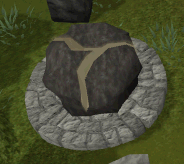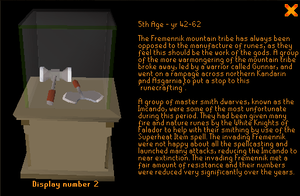Runecrafting Crusades
The Runecrafting Crusades were a series of armed invasions led by the Fremennik warrior Gunnar during the years 42 to 62 of the Fifth Age. The invasions were a direct response to several human nations' use of magic, which some Fremenniks felt defied the will of the gods.
The attacks were unsuccessful, although the kingdoms of Kandarin, Misthalin, and Asgarnia suffered heavy losses under the weight of the brutal attacks. A further set of crusades was planned, but never occurred due to the burning of the original Wizards' Tower.
History
Background
The Fremenniks
Since the Fremenniks arrived in the First Age from the far north, many have felt that magic is a gift to be used only by the gods. For most of history, all but a select few humans have been incapable of using magic simply due to the lack of controllable magic in the race as a whole.
The Fremenniks have opposed mortals' use of magic, and the monstrosities unleashed by magical races during the great God Wars surely only made their hate of the art even stronger. Having no desire to use it, the Fremenniks were content with the decline of the art as the Fourth Age progressed and many magical races were overcome by humans.
The Discovery of Runes
In the last days of the Fourth Age, however, a Fremennik seer discovered an ancient cave beneath the mountains of the eastern Fremennik Province. Here the seer discovered the Stone of Jas, a strange and powerful artefact that, in some way, had caused the stones near it to become rune essence. Although the Stone of Jas was "removed by those who walk a higher astral path" upon its discovery, the rune essence it had created was not.

The seer, realising that these stones could be mentally crafted into runes that allowed humans to cast magic, brought the new discovery to the kingdom of Misthalin. Here, before a group of various civilians from the Misthalanian capital city of Varrock, the seer displayed simple tricks he could perform with the runes, such as creating a small gust of wind. At the time, this was marvel.
This discovery would mark the beginning of the Fifth Age, a time of massive progression.
The Spread of Runecrafting
Word of this new art of magic exploded throughout the human kingdoms, many pro-magic Fremenniks travelling further south and constructing altars in locations that would allow even untrained humans to craft runes. As magic became increasingly common and runes came into mass production, many in the Fremennik Tribe became outraged by its use. A massive internal struggle within the tribe eventually resulted in nearly half of its people banished to the cold Lunar Sea in the north. Here, these Fremenniks would form the Moon Clan, and for years they would delve deeper into magic than any others. Yet another faction would break off and live in the mountains to the east, leaving the Fremennik tribe somewhat smaller but still highly dangerous.
Yet, even without the Moon Clan's aid, humans in kingdoms such as Misthalin, Asgarnia, and Kandarin were able to use magic to their advantage. Now able to more adequetly defend themselves against giants, goblins, and other hostile races, these kingdoms began to expand their borders and prosper.
For nearly 40 years most of humanity would prosper with the aid of runestones, with unrivalled strides in nearly every aspect of life. A great tower of wizardry was erected in southern Misthalin, yet even as humanity prospered the Fremenniks grew increasingly hostile.
The Start of the Crusades
Many Fremenniks felt that a passive approach to the situation would not suffice. Some even felt that, to stop the use of magic, the growing kingdoms to the south had to be stomped out before they became unstoppable. This caused a great stir amongst the inhabitants of the Fremennik city of Rellekka, who had already seen the departure of several factions in the last 40 years.
Despite this, tension only grew. This hostility eventually materialised under the Fremennik warlord Gunnar, who rallied support from the people of Rellekka and other outlying villages. Gunnar, intent on stopping Runecrafting entirely, led a massive military force into the largely unclaimed woodlands south of the Fremennik Province, where the emerging nation of Kandarin was just beginning to solidify under the city of Ardougne.
Conflict in Kandarin and Asgarnia
Kandarin, despite being largely uninhabited, suffered immediate losses at the hands of the invaders. Pillaging and destroying those few settlements in the northern reaches of the kingdom, the Fremenniks were a cause of great concern in regions such as Misthalin, Asgarnia, and Crandor.
Intent on defeating any human nation supporting the use of magic, the Fremenniks advanced further east, making no secret of their mission. Their years in the bitter ice fields of the north served them well, allowing them, even in their great numbers, to pass over White Wolf Mountain relatively unscathed.
Once across White Wolf Mountain, the Gunnar's army was left with no significant geographical borders to cross, leaving Asgarnia to defend itself. Falador, at the time a fast-growing but still comparatively small city, was put to the test. The White Knights and Kinshra that protected the city, under King Raddallin, were able to repel the crusaders eventually, but northern Asgarnia suffered heavy losses under the attacks.
According to Baba Yaga, the Fremennik reduced the outer temples of the runecrafting altars to ruins, but were unable to enter, so the inner temples were left intact.
Barbarian Sympathizers
Within several years, the barbarians were already pushing their way into Asgarnia. Word of this was cause for great concern to any human settlement. Despite the massive retaliation against the Crusades by many governments, there were some in Misthalin and Al-Kharid that felt that this new art was dangerous and that the Crusades were a justifiable course of action.
In the year 47, a large number of warriors trained in traditional combat took up arms against the Mage Training Arena, a facility in northern Al-Kharid that had been built in the year 9. The Arena had been designed by the same mages that constructed the Wizards' Tower, its goal to prevent accidents and train those unskilled in magical arts.
The Arena, despite being protected by powerful guardians constructed of rune essence, was unable to stand against the attack. The Arena fell, creating much internal conflict amongst Misthalin and its neighbours.
The Imcando Dwarves

The crusaders, unable to take Falador or reach southern Asgarnia, bided their time in the cold forests north of the city for years, pillaging small settlements and planning their next offensive.
The Imcando Dwarves, a race of peaceful blacksmiths that lived within Ice Mountain north of Falador, were perhaps the greatest victims of the Crusades. Prior to the Fremenniks' arrival in Asgarnia, the White Knights had given the Imcando a number of fire and nature runes with which they could superheat ore, thus aiding the smithing process. The crusaders, hearing of this, launched a full-scale assault on the dwarves living on Ice Mountain in the Hall of Camdozaal. Untrained in the art of war, the Imcando were decimated and Camdozaal destroyed, their race forced to near extinction. Although a very small number were able to escape the attack, this would mark the end of the Imcando's prosperity.
The End of the Crusades
Despite launching many successful waves of attacks, by the early 60s the Fremennik Crusaders were dwindling from their years of combat. Despite this, they pushed on through Asgarnia, their eyes set on Misthalin and its capital city of Varrock.
With their numbers constantly decreasing and supplies becoming more and more difficult to obtain, however, the Crusaders found themselves in an increasingly dire situation. In the year 62, Gunnar, now considerably aged, led his people to the River Lum, where the Fremenniks decided to establish a settlement on the river's western side. Here they established Gunnarsgrunn, where they initially intended to re-amass their forces for a second series of attacks. The governments of Misthalin and Asgarnia, not wanting to immediately provoke them, held off any retaliation.
Eight years later, though, in the year 70, runecrafting was still at its peak, and the threat of a second series of Crusades had faded from the minds of most. This confidence was betrayed when a collection of Zamorakians amongst the Tower's order burned the Tower in an effort to end Saradominist supremecy in the region. With the loss of most of the order and the destruction of many important tomes and artefacts, the closely guarded secret of the runecrafting process was lost. Furthermore, as the rune supply dwindled and hostile races began to pose a greater threat, confidence in magic began to diminish amongst the human populace. The Winter of 114 caused many to shift their studies to science, which they hoped could replace magic as a form of defence.

With runecrafting lost, the Fremenniks saw no need to launch a second wave of attacks, and as a result they never happened. Even today, almost 100 years later, their descendents continue to live peacefully in their village near the River Lum. The re-discovery of runecrafting in the Rune Mysteries quest does not seem to have drawn a strong response from the tribe, suggesting that their views have become less conflicting with their neighbors; some tribe members have even begun to live in cities such as Varrock.
Trivia
- The real-world Crusades were a series of religiously-sanctioned military campaigns led by Christians in their efforts to reclaim the Holy Land. Although they occur in a similar time period, the RuneCrafting Crusades as a whole are not extremely similar to their real-world counterparts in terms of motivation or execution.